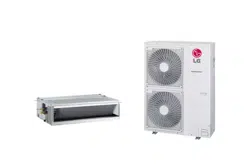Loading ...
Loading ...
Loading ...

LEAKAGE TEST AND EVACUATION
29
ENGLISH
Air and moisture remaining in the refrigerant system have undesirable effects as indicated below.
- Pressure in the system rises.
- Operating current rises.
- Cooling (or heating) efficiency drops.
- Moisture in the refrigerant circuit may freeze and block capillary tubing.
- Water may lead to corrosion of parts in the refrigeration system.
Therefore, the indoor/outdoor unit and connecting tube must be checked for leak tight, and
vacuumed to remove incondensible gas and moisture in the system.
- Pressurize the system to no more than 3.8 MPa with dry nitrogen gas and close the cylinder
valve when the gauge reading reached 3.8 MPa Next, test for leaks using bubble test solution.
CAUTION
!
Be sure to use a manifold valve for leakage test. If it is not available, use a stop valve for this
purpose. The "Hi" knob of the manifold valve must always be kept close.
CAUTION
!
To avoid nitrogen entering the refrigerant system in a liquid state, the top of the cylinder
must be higher than its bottom when you pressurize the system. Usually, the cylinder is
used in a vertical standing position.
Preparation
- Check that each tube (both liquid and gas side tubes) between the indoor and outdoor units
have been properly connected and all wiring for the test run have been completed. Remove the
service valve caps from both the gas and the liquid side on the outdoor unit. Check that both the
liquid and the gas side service valves on the outdoor unit are kept closed at this stage.
Leakage test
- Connect the manifold valve (with pressure gauges) and dry nitrogen gas cylinder to this service
port with charge hoses.
LEAKAGE TEST AND EVACUATION
Loading ...
Loading ...
Loading ...
